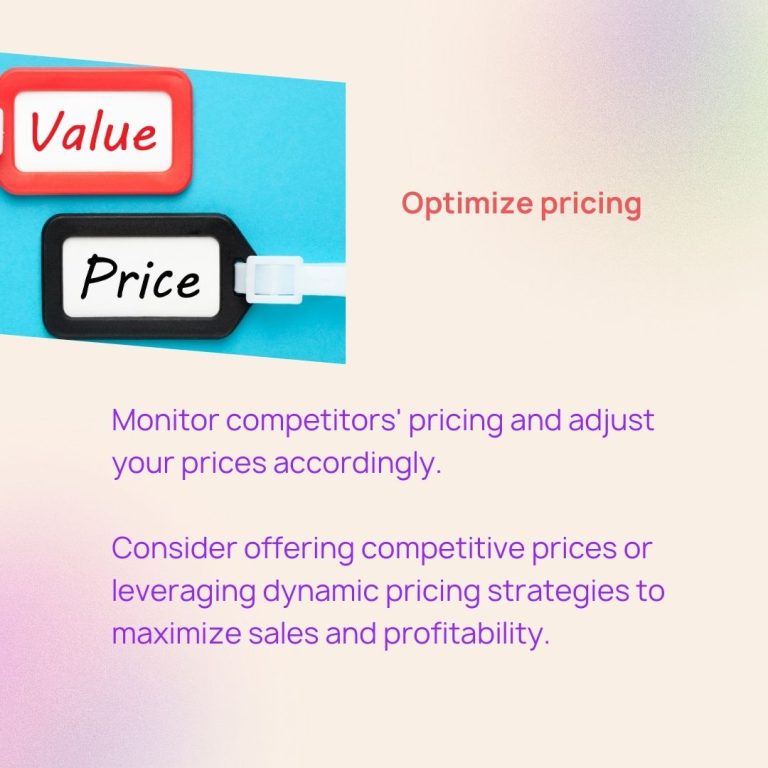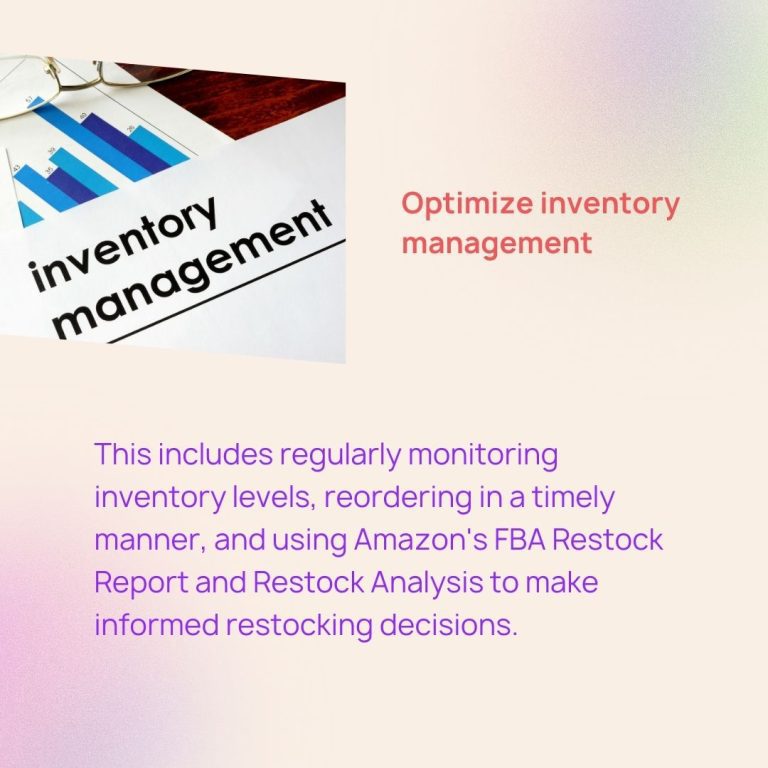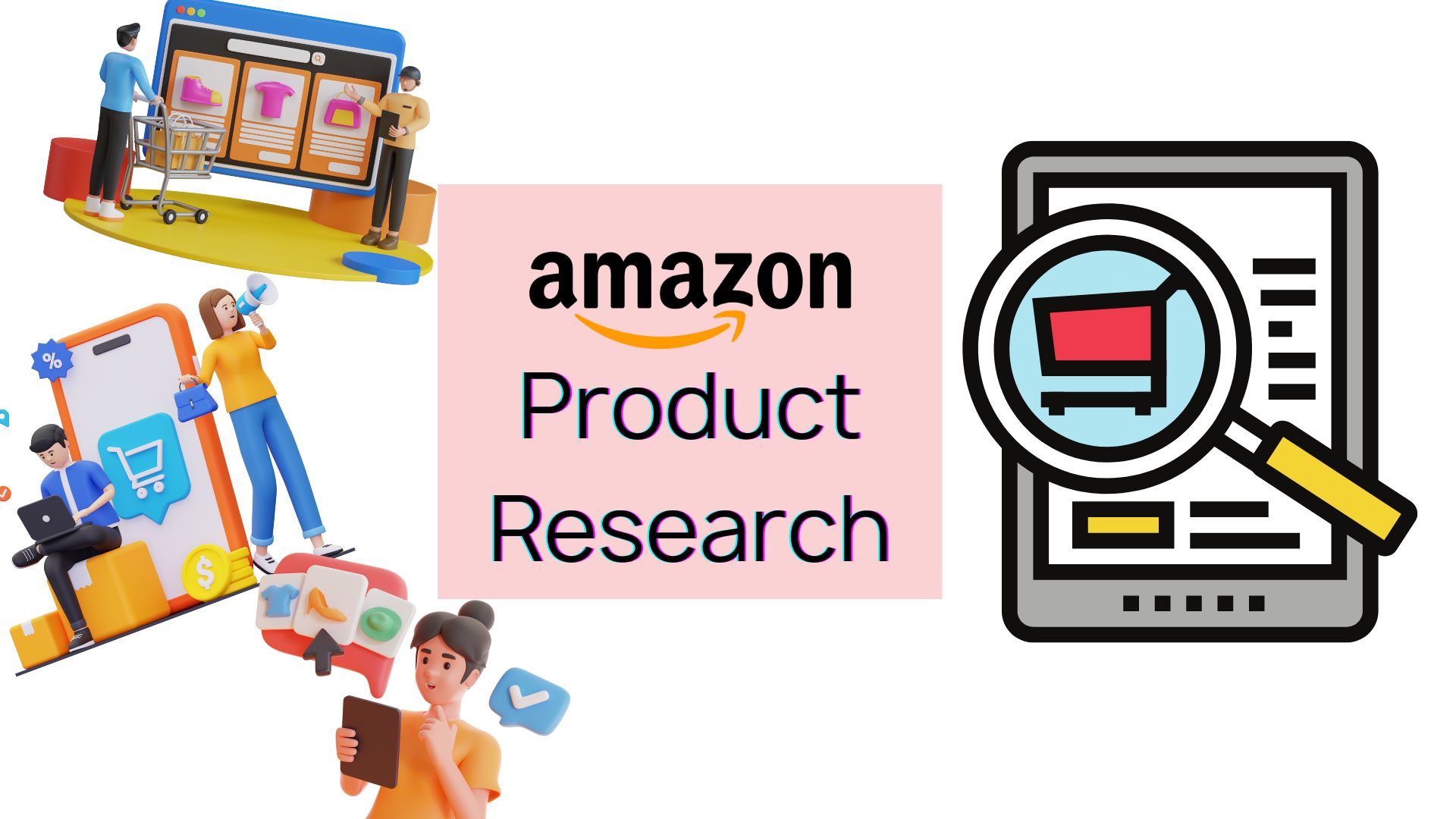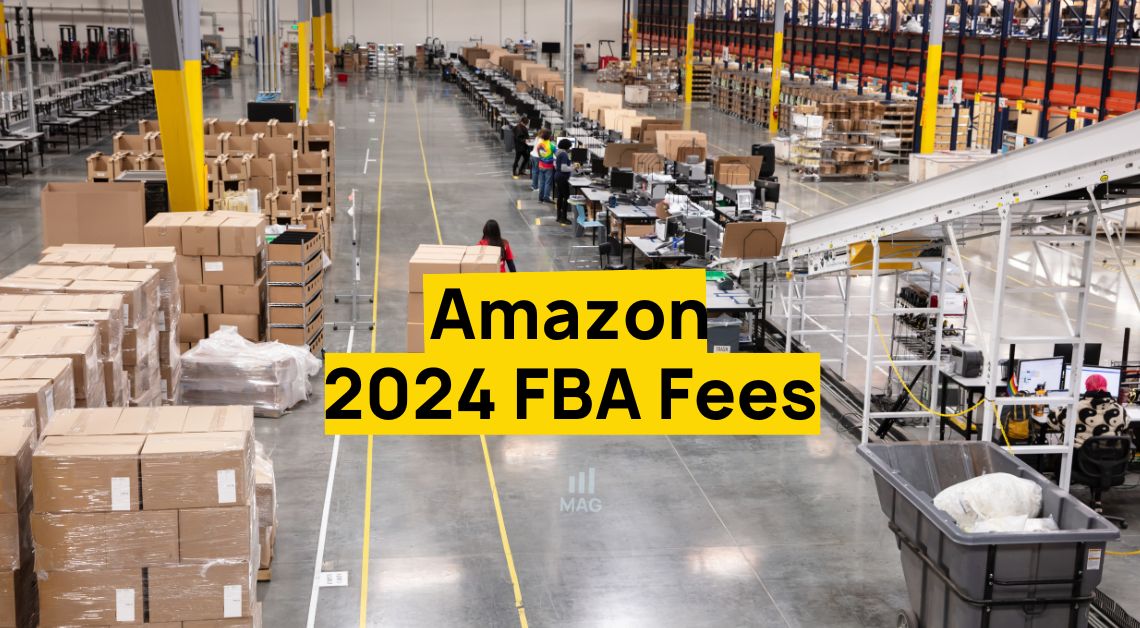Optimizing Amazon FBA inventory management empowers you to maintain seamless operations, maximize sales, and deliver exceptional customer satisfaction through consistent product availability and timely shipping.
In our previous blog post about pricing and fees, we already talked about managing FBA inventory in order to keep a seller’s expenses to a minimum. However, this is a topic that deserves its own article. After all, an important rule that our Amazon FBA agency often preaches to sellers is:

Amazon FBA Inventory Management: Inventory Planning
Forecasting demand
Forecasting demand plays a pivotal role in Amazon FBA inventory management, enabling sellers to anticipate customer needs accurately, optimize stock levels, and reduce the risk of stockouts or overstocking.
- Forecasting demand for FBA products involves a systematic approach that combines historical data, market trends, and other relevant factors. Here’s a concise guide on how to effectively forecast demand for your FBA products:
- Analyze Historical Data: Examine past sales data, preferably over a significant period, to identify patterns, seasonal fluctuations, and trends.
- Market Research: Study industry trends, consumer behavior, and market dynamics to understand external factors that might influence demand.
- Seasonal Patterns: Recognize and account for seasonal variations that can impact demand, such as holidays or specific events.
- Competitor Analysis: Monitor competitors’ performance and their product demand trends to gain insights into market trends and customer preferences.
- Sales Channels: If you sell across multiple platforms, consider integrating data from those channels to get a comprehensive demand overview.
- New Product Launches: When introducing new products, use market research and pre-launch promotions to gauge potential demand.
- Consumer Feedback: Customer reviews, surveys, and feedback can offer valuable insights into product demand and improvements.
- Collaboration: Engage with your sales and marketing teams to gather insights from customer interactions and promotional campaigns.
- Statistical Models: Employ statistical techniques like moving averages, exponential smoothing, or regression analysis to project future demand.
- Technology: Utilize demand forecasting software or tools that can analyze data and provide accurate predictions.
- Safety Stock: Factor in safety stock to account for unexpected demand spikes or supply chain disruptions.
- Adjust and Refine: Regularly review and adjust your forecasts based on new data and changing market conditions.
Learn more about Demand Forecasting by reading another article in our Amazon FBA agency blog
In Seller Central, go to Inventory > Inventory Planning.
Click “Inventory Planning”, then hover your mouse on the “Inventory” tab to prompt the drop-down menu where you can select “Restock Inventory.”
Once on the Restock Inventory page, you can click “Sales Summary” > “View Forecast”.
A pop-up page will appear to show you 40 weeks’ worth of estimated future demand based on a probabilistic forecast model.
Strategies to Capitalize on Increased Demand During Peak Seasons
FBA sellers can employ several strategies to capitalize on increased demand during peak seasons. Here are some key strategies:








Amazon FBA Inventory Management: Inventory Replenishment
Reordering Strategies
Reordering strategies for FBA sellers to replenish inventory can include:
- Set up automatic reorder rules: Utilize Amazon’s replenishment alerts and inventory planning tools to automatically trigger reorders when inventory levels reach a certain threshold. This can help ensure a continuous supply of stock without the need for manual monitoring.
- Analyze sales velocity and lead time: Calculate your product’s average daily sales and the time it takes for a new shipment to arrive at Amazon’s fulfillment centers. Based on this data, determine the reorder point that allows for a seamless transition between inventory batches.
- Implement safety stock: To mitigate the risk of stockouts, maintain a buffer of safety stock. This involves ordering additional units beyond the calculated reorder point to account for unexpected spikes in demand or delayed shipments.
- Use historical data and trends: Analyze past sales data and seasonal trends to forecast future demand. This can help you anticipate spikes in sales and plan accordingly to avoid stockouts or overstocking.
- Establish good relationships with suppliers: Maintain open lines of communication with your suppliers to ensure a smooth ordering process. This includes negotiating favorable terms, discussing lead times, and staying updated on any potential disruptions in the supply chain.
- Consider alternative sourcing options: Explore multiple suppliers or manufacturers to diversify your supply chain and reduce the risk of inventory disruptions. This can help mitigate issues such as production delays or supplier shortages.
- Utilize inventory management software: Invest in inventory management software that can automate and streamline the reorder process. These tools can provide real-time insights into inventory levels, sales performance, and reorder suggestions.
Vendor management
Creating and maintaining strong relationships with suppliers is crucial for an Amazon FBA seller’s success. A healthy partnership ensures a consistent flow of high-quality products and favorable terms. Here’s how to build those relationships and negotiate terms that benefit both parties:
- Communication is Key:
- Open Dialogue: Maintain transparent and open communication with your suppliers.
- Regular Updates: Keep them informed about your business growth, plans, and any changes that might impact your orders.
- Consistent Orders:
- Reliable Orders: Place consistent and predictable orders to build trust and reliability.
- Minimize Fluctuations: Avoid sudden spikes or drops in orders that can disrupt their production schedules.
- Timely Payments:
- Prompt Payment: Pay your invoices on time to establish a reputation as a reliable and trustworthy partner.
- Negotiate Discounts: Negotiate early payment discounts as an incentive for prompt payments.
- Understand Their Business:
- Market Insights: Understand your supplier’s industry challenges, market trends, and pain points.
- Mutual Benefits: Look for ways to align your goals and help each other succeed.
- Visit Their Facilities:
- Face-to-Face: If feasible, visit your supplier’s facilities to understand their processes and build a personal connection.
- Relationship Strengthening: Meeting in person can foster a deeper understanding and trust.
- Long-Term Perspective:
- Partnership Mindset: Approach the relationship as a long-term partnership, not just a transaction.
- Benefits of Loyalty: Suppliers may offer better terms and prioritize your orders if they view you as a loyal customer.
- Collaborative Problem Solving:
- Address Issues Together: If problems arise, work collaboratively to find solutions rather than placing blame.
- Win-Win Solutions: Strive for outcomes that benefit both parties.
- Negotiating Favorable Terms:
- Prepare Thoroughly: Research your supplier’s industry standards and competitors to have a strong negotiation position.
- Value Proposition: Clearly communicate how your business can add value to the supplier’s growth.
- Leverage Volume: If your order volume is significant, use it as leverage to negotiate better pricing or terms.
- Quantity Discounts:
- Bulk Orders: Commit to larger order quantities in exchange for volume discounts.
- Tiered Pricing: Negotiate tiered pricing that rewards higher volumes with better unit prices.
- Payment Terms:
- Extended Terms: Request extended payment terms to improve cash flow for your business.
- Early Payment Discounts: Negotiate discounts for early or upfront payments.
- Exclusive Agreements:
- Exclusivity Benefits: Offer exclusive partnerships to suppliers in exchange for better terms or priority in supply.
- Continuous Improvement:
- Regular Review: Periodically review the terms and performance of your supplier agreements.
- Feedback Loop: Provide constructive feedback to suppliers on areas for improvement.
- Win-Win Approach:
- Mutually Beneficial: Approach negotiations with the goal of achieving a win-win outcome.
- Long-Term Value: Focus on building a relationship that benefits both parties over time.
Here are some informative videos from My Amazon Guy about sourcing products.
Can FBA Sellers Use Just-In-Time (Jit) Inventory
Yes, FBA sellers can use Just-in-time (JIT) inventory management. JIT inventory management is a strategy where inventory is ordered and received just in time for production or shipment, reducing the amount of inventory held in stock.
This approach helps to minimize storage costs and optimize cash flow. FBA sellers can adopt JIT inventory management by closely monitoring their inventory levels and placing orders with suppliers accordingly to ensure timely delivery to Amazon fulfillment centers.
Benefits of JIT for FBA
- Cost Reduction: JIT can help reduce inventory costs by minimizing the amount of inventory stored in Amazon’s fulfillment centers. By maintaining a lean inventory, sellers can avoid unnecessary storage fees and reduce the risk of holding obsolete or slow-moving products.
- Improved Cash Flow: With JIT, sellers can optimize their cash flow by reducing the amount of capital tied up in inventory. By only ordering and storing the necessary inventory levels, sellers can free up funds to invest in other areas of their business.
- Reduced Lead Time: JIT focuses on delivering products to Amazon’s fulfillment centers just-in-time for customer orders. By minimizing lead time, sellers can improve order fulfillment speed, which can enhance customer satisfaction and potentially lead to higher sales.
- Enhanced Inventory Turnover: JIT encourages a higher inventory turnover rate, which means products are selling quickly rather than sitting in warehouses. A higher turnover rate can lead to improved profitability and a healthier business.
- Flexibility and Agility: JIT allows sellers to adapt to changing market demand more effectively. By closely monitoring sales trends and adjusting their inventory levels accordingly, sellers can quickly respond to fluctuations in demand and avoid stockouts or overstock situations.
- Reduced Risk of Obsolescence: By maintaining a lean inventory, sellers can minimize the risk of holding onto products that become outdated or lose their market appeal. This can help sellers stay competitive and avoid losses associated with obsolete inventory.
Amazon FBA Inventory Management: Inventory Storage and Organization
Can Labeling And Barcoding Help With FBA Inventory Management
Yes, labeling and barcoding are essential for FBA inventory management. They help in the accurate identification and tracking of products throughout the fulfillment process.
By properly labeling and barcoding your products, you can ensure that they are correctly received, stored, and shipped by Amazon.
This helps in reducing errors, improving inventory accuracy, and streamlining the overall FBA inventory management process.
Inventory tracking
When it comes to FBA inventory tracking, there are several methods you can use to effectively manage and monitor your inventory. Here are a few commonly used methods:
- Amazon’s FBA Inventory Reports: Amazon provides various reports to track your FBA inventory. These reports include the Inventory Health Report, which gives you an overview of your inventory’s health and potential issues, and the Reserved Inventory Report, which shows the quantity of your inventory that is reserved for pending orders.
- FBA Inventory Tools: There are third-party inventory management tools available that can help you track your FBA inventory. These tools often provide more detailed and customizable reports, allowing you to analyze sales data, inventory levels, and other metrics at a SKU level basis. Some popular FBA inventory tools include Jungle Scout, Helium 10, and SellerApp.
- Manual Spreadsheet Tracking: If you prefer a more hands-on approach, you can track your FBA inventory using manual spreadsheets. This method involves manually updating and recording your inventory levels, sales data, and other relevant information. While it requires more effort, it can be a cost-effective option for smaller sellers.
- Barcode Scanning Systems: Utilizing barcode scanning systems can streamline the inventory tracking process. By scanning barcodes on your products, you can easily update inventory levels and track sales in real-time. This method can help minimize human errors and improve efficiency.
Amazon FBA Inventory Management: Inventory Health and Performance
Effective Strategies for Monitoring Inventory Health Metrics
Monitoring FBA inventory health metrics is crucial for maintaining a healthy inventory and avoiding any potential issues. Here are some effective strategies for monitoring FBA inventory health metrics:
- Utilize Amazon’s Inventory Performance Index (IPI): Amazon provides an IPI score that measures your inventory performance. Aim to keep your IPI score above 450 to avoid storage fees and other penalties. Regularly monitor your IPI score and take necessary actions to improve it if needed.
- Use the FBA Inventory Dashboard: Amazon offers the FBA Inventory Dashboard, which provides insights into your inventory health metrics, such as excess inventory, stranded inventory, and sell-through rates. Regularly review this dashboard to identify any issues and take appropriate actions.
- Set up replenishment alerts: Configure automatic replenishment alerts in your inventory management system or through Amazon Seller Central. These alerts will notify you when inventory levels reach a certain threshold, allowing you to reorder in a timely manner.
- Monitor sell-through rates: Keep a close eye on your sell-through rates, which indicate how quickly your inventory is selling. Low sell-through rates may indicate slow-moving or stagnant inventory. Take necessary actions, such as optimizing listings or running promotions, to improve sell-through rates.
- Analyze inventory health reports: Amazon provides various inventory health reports, such as the Stranded Inventory report, Excess Inventory report, and Inbound Performance report. Regularly analyze these reports to identify any issues and take corrective measures.
- Use inventory management software: Invest in inventory management software that can integrate with Amazon and provide real-time data on inventory health metrics. These tools can help you track and analyze metrics more efficiently.
- Conduct regular inventory audits: Perform regular physical inventory audits to ensure accuracy and identify any discrepancies. This will help you identify any stockouts, overstocking, or other inventory issues that need to be addressed.
Managing Aged FBA Inventory
Amazon FBA Inventory Management: Inventory Visibility and Reporting
Real-Time FBA Inventory Visibility for Informed Decisions and Preventing Stockouts
Real-time FBA inventory visibility is crucial for making informed decisions and preventing stockouts. By having access to accurate and up-to-date inventory data, sellers can monitor their stock levels in real-time and take necessary actions to avoid running out of stock. This helps them maintain a steady supply of products, meet customer demand, and prevent potential loss of sales.
Here are some tips to help you achieve and maintain real-time visibility:
- Enable and use Amazon’s FBA Inventory Management Tool: Amazon provides a robust FBA inventory management tool that allows you to track your inventory levels in real-time. Make sure to enable this feature and regularly check it to stay updated on your inventory status.
- Utilize inventory management software: There are several third-party software solutions available that can integrate with Amazon’s FBA system to provide real-time inventory visibility. These tools can automate inventory tracking, alert you of low stock levels, and help you manage reordering efficiently.
- Regularly reconcile your inventory: Conduct frequent inventory reconciliations to ensure that your physical inventory matches the inventory shown in your Amazon Seller Central account. This will help identify any discrepancies and prevent stockouts or overselling.
- Set up replenishment alerts: Configure replenishment alerts based on your sales velocity and lead time to ensure you restock your inventory before it runs out. This will help you maintain a healthy stock level and avoid missing out on potential sales.
- Leverage Amazon’s restock inventory recommendations: Amazon provides recommendations for restocking inventory based on your sales history and projected demand. Consider using these recommendations as a starting point for your inventory planning.
- Monitor sales velocity and adjust inventory levels: Track your sales velocity for each SKU and adjust your inventory levels accordingly. If a product is selling well, you may want to increase your stock to avoid running out. Conversely, if a product is not selling as expected, you may need to adjust your inventory levels to prevent excess stock.
- Optimize your inventory storage: Efficiently manage your inventory storage to minimize storage fees and maximize sales. Regularly review your inventory to identify slow-moving or stagnant products and consider implementing strategies like bundling or promotions to clear out excess inventory.
Generating inventory reports
Watch this video on how to download and use an inventory report.
Amazon FBA Inventory Management: Leveraging Repricing
Repricing is a strategy used by sellers to dynamically adjust the prices of their products on Amazon in order to stay competitive and maximize sales. While repricing can be an effective tool for managing FBA inventory, it is important to note that repricing alone may not be sufficient for comprehensive inventory management.
To effectively leverage repricing for FBA inventory management, you can follow these steps:
- Set your repricing strategy: Determine your pricing goals, such as maximizing profit margin, winning the Buy Box, or increasing sales velocity. Set minimum and maximum price thresholds to ensure you don’t sell at unprofitable prices or violate Amazon’s pricing policies.
- Monitor competition: Regularly monitor the prices and inventory levels of your competitors. This information can help you make informed repricing decisions to stay competitive.
- Use repricing software: Consider using repricing software tools that automate the repricing process based on your predefined rules and strategies. These tools can help you stay competitive and respond quickly to market changes.
- Consider additional factors: While repricing is mainly focused on pricing adjustments, it’s important to consider other factors such as product demand, seasonality, and inventory levels. Make sure to take these factors into account when setting your repricing rules.
- Analyze and adjust: Continuously analyze the impact of your repricing strategy on your FBA inventory. Regularly review your sales metrics, profitability, and inventory levels to make necessary adjustments to your repricing rules.
Amazon FBA Inventory Management: Inventory Liquidation and Clearance
Strategies for selling slow-moving inventory
When it comes to selling slow-moving inventory on Amazon, there are several strategies you can consider:
- Price Optimization: Review your pricing strategy for the slow-moving items. Consider lowering the price to attract more buyers and increase sales velocity. You can also experiment with running promotions or offering discounts to incentivize purchases.
- Improve Product Visibility: Enhance the visibility of your slow-moving inventory by optimizing your product listings. Make sure your product titles, bullet points, and descriptions are relevant, and informative, and include relevant keywords. Additionally, consider optimizing your product images and utilizing Amazon Advertising to increase visibility through sponsored ads.
- Offer Bundles or Multi-Packs: Create bundle offers or multi-packs with your slow-moving inventory. This can help increase the perceived value of the products and encourage customers to make a purchase.
- Run Targeted Marketing Campaigns: Utilize Amazon’s advertising tools, such as Sponsored Products and Sponsored Brands, to run targeted campaigns for your slow-moving inventory. This can help generate more visibility and drive traffic to your listings.
- Cross-Promotion: Cross-promote your slow-moving items within your own product listings. For example, if you have a best-selling product, include a section or a call-to-action mentioning the slow-moving item as a related or complementary product.
- Utilize Amazon’s Deals and Promotions: Take advantage of Amazon’s deals and promotions, such as Lightning Deals or Coupons, to create urgency and attract more customers. These promotions can help increase visibility and drive sales for your slow-moving inventory.
- Optimize Inventory Placement: Consider using Amazon’s inventory placement services to strategically place your slow-moving inventory in fulfillment centers closer to the customers who are more likely to purchase them. This can help reduce fulfillment costs and improve delivery times, potentially increasing sales.
- Liquidation or Wholesale: If all else fails, you can explore options like liquidating the slow-moving inventory through clearance sales or selling them in bulk to wholesalers or liquidation companies.
FBA inventory Liquidation Best Practices
- Evaluate the profitability: Before deciding to liquidate your excess inventory, make sure to assess its potential profitability. Determine if the cost of liquidation and potential credit from Amazon outweigh the potential profit from selling the items elsewhere.
- Understand the FBA Liquidations program: Familiarize yourself with the FBA Liquidations program offered by Amazon. This program allows sellers to send excess inventory to Amazon, which will handle the liquidation process and potentially provide a credit to the seller’s account.
- Review the eligibility criteria: Ensure that your inventory meets Amazon’s eligibility criteria for liquidation. Certain items may not be eligible due to restrictions or hazardous materials.
- Optimize for maximum return: Take steps to optimize your liquidation process to maximize your return. This may involve bundling similar products, offering discounts, or using marketing strategies to attract buyers.
- Consider alternative liquidation options: While the FBA Liquidations program is one option, there are also third-party liquidation companies that specialize in handling excess inventory. Evaluate these alternatives to determine if they offer better terms or returns.
- Monitor liquidation performance: Keep a close eye on the liquidation process to ensure it is progressing smoothly. Stay in communication with Amazon or the liquidation company to address any issues or questions that may arise.
Amazon FBA Inventory Management: Inventory Returns and Refunds
Managing customer returns
To manage customer returns for FBA inventory, Amazon sellers can follow the following steps:
- Monitor Refunds: Sellers should regularly check the “Payments” section in Seller Central to view the refunds they have received from Amazon. This report will show all the orders for which the seller received a refund from Amazon.
- Download Returns Report: In order to determine whether refunded units were shipped back to Amazon or if any returned items were not refunded, sellers need to download the FBA Customer Returns report. This report can be found under the “Fulfillment” section in the “Reports” tab on Seller Central. The report should cover the same date range as the Refunds report.
- Compare Order IDs: Once the Returns Report is downloaded, sellers should compare the Order IDs in this report with those in the Refunds report. This will help identify any refunded orders that are missing from the Returns Report.
- Identify Missing Refunds: If an Order ID is marked as “N/A” in the Returns Report, it means that it has not been refunded yet. Sellers should monitor these Order IDs that are more than 45 days old and still marked as “N/A”. If an Amazon return has not been refunded after 50 days, the seller should open a case to request reimbursement.
- Open Reimbursement Cases: To expedite the process, sellers can split their Order IDs into batches of 10-15 and open separate cases for each batch. This allows Amazon to attend to each batch more quickly.
For additional information about FBA returns, here are some videos to watch.
Handling damaged or unsellable inventory
When it comes to handling damaged or unsellable inventory on Amazon, there are a few steps you can take:
- Identify the damaged or unsellable inventory: Regularly review your inventory and identify any items that are damaged, expired, or otherwise unsellable.
- Separate the damaged inventory: Set aside the damaged or unsellable items from your sellable inventory to avoid any confusion or mix-ups.
- Report the damaged inventory to Amazon: Go into your Amazon seller account and download a list of the damaged items. You can use this list to report the damaged inventory to Amazon.
- File a reimbursement claim: If the damaged inventory was due to Amazon’s handling, you may be eligible for reimbursement. Enter the FNSKU of each damaged item into Amazon’s “Investigate an Item Lost in Warehouse” page and click on the “Create a Case” button. Wait for Amazon’s response and provide any necessary documentation to support your claim.
- Check warehouse damaged reimbursement status: Additionally, you can check the reimbursement status of your damaged items by going to Amazon’s “check warehouse damaged reimbursement status” page. Paste in each transaction ID for eligible items and review the status of your claim.
- Review the case log: If your reimbursement claim is successful, a case will be created for the claim, and you can review it in the case log for any updates or further actions required.
Streamlining refund processes
To streamline refund processes for Amazon seller listings, you can follow these steps:
- Access the messages and click on the Order ID to go to the Order Details page.
- Click on the Refund Order button.
- Choose General Adjustment as the Reason for Refund.
- Enter the refund amount or issue a full refund in the amount box and then submit the refund.
- Reply to the buyer’s message to notify them that the refund has been processed and issued to their account.
Amazon FBA Inventory Management: Risk Management
Identifying and mitigating inventory risks
Identifying and mitigating FBA inventory risks is crucial for sellers to maintain successful operations on the platform. Here are some key steps and strategies to consider:
- Forecasting and Demand Planning: Accurate forecasting of product demand is essential to prevent overstocking or understocking. Utilize historical sales data, market trends, and seasonality to forecast inventory needs.
- Monitoring Inventory Levels: Regularly monitor your inventory levels to avoid running out of stock or facing long-term storage fees. Set up automated inventory alerts and utilize Amazon’s FBA Inventory Dashboard to track your inventory health.
- Replenishment and Lead Time Management: Maintain a well-planned and efficient replenishment strategy. Consider lead times for production, shipping, and customs clearance to avoid stockouts and delays.
- Inventory Performance Index (IPI) Optimization: Amazon’s IPI measures a seller’s inventory performance and can impact storage limits and costs. Focus on maintaining a high IPI by minimizing excess inventory, improving sell-through rates, and resolving stock issues promptly.
- Seasonal Inventory Planning: Plan ahead for peak seasons and holidays by adjusting your inventory levels accordingly. This will help you meet customer demand and maximize sales opportunities.
- Diversify Fulfillment Options: Consider utilizing multiple fulfillment methods like FBM (Fulfillment by Merchant) or multi-channel fulfillment to spread the risk and ensure continuity of operations.
- Reviewing Storage Fees and FBA Costs: Regularly evaluate your storage fees and FBA costs to optimize profitability. Identify slow-moving or non-performing inventory and make informed decisions on liquidation or removal.
- Analyzing Sales Data and Trends: Continuously analyze your sales data to identify patterns, understand customer behavior, and make data-driven decisions regarding inventory management.
Aging is also an inventory risk, and here’s a video on FBA inventory aging.
Safety stock planning
When it comes to planning safety stock for FBA, it is generally recommended to have at least 60 days’ worth of stock in a warehouse with 3PL (third-party logistics).
This allows for a buffer in case of unexpected events or delays, ensuring that you can continue fulfilling orders without running out of inventory.
This strategy helps protect your business from potential disruptions and allows for smoother operations on the Amazon platform.
Contingency plans for supply chain disruptions
Contingency plans for supply chain disruptions are crucial for ensuring smooth operations in Amazon selling. Here are a few suggestions that can help mitigate the impact of disruptions:
- Diversify suppliers: Relying on a single supplier increases the risk of disruptions. Consider working with multiple suppliers to have a backup option in case one supplier experiences difficulties.
- Safety stock: As mentioned in the database content, it is suggested to have a year supply of stock on hand. Maintaining an adequate inventory level can help you navigate through disruptions without running out of stock.
- Monitor inventory levels: Implement a robust inventory management system that allows you to track stock levels accurately. Regularly monitor your inventory to identify any potential shortages or excesses.
- Build strong relationships with suppliers: Establishing good relationships with your suppliers can be beneficial during disruptions. Maintaining open lines of communication and discussing contingency plans with your suppliers can help ensure timely delivery and alternative solutions.
- Explore alternative shipping methods: During disruptions, traditional shipping methods may face delays or restrictions. It’s worth exploring alternative shipping methods, such as air freight or local fulfillment options, to minimize the impact on your operations.
- Stay informed: Keep yourself updated on industry news, global events, and potential disruptions that may affect your supply chain. This will allow you to proactively address any challenges that may arise.
Conclusion
Amazon FBA inventory management is crucial for a seller’s success because it ensures fast and reliable fulfillment, maximizing customer satisfaction. It also allows sellers to leverage the Prime eligibility, tapping into a larger customer base and increasing sales potential.
Additionally, effective inventory management through FBA helps sellers optimize their inventory levels, minimizing storage costs and avoiding stockouts or overstocking.
Bonus: Questions To Ask When Managing FBA Inventory
When managing FBA inventory, here are some important questions to consider:
- How is the demand for my products? It’s essential to monitor the sales velocity and popularity of your products to ensure you have the right amount of inventory on hand.
- Are there any upcoming promotions or seasonal spikes? Anticipating increased demand during promotional events or seasonal periods can help you plan your inventory levels accordingly and avoid stockouts.
- What is the lead time for restocking inventory? Understanding the time it takes for your products to be replenished can help you avoid running out of stock and ensure a seamless supply chain.
- Are there any slow-moving or aging products? Identifying slow-moving or aging inventory is crucial to avoid tying up capital and storage space. Consider implementing strategies to liquidate or remove such inventory.
- How accurate are my inventory forecasts? Regularly reviewing and refining your inventory forecasting methods can help you make more informed decisions about replenishment and prevent excess inventory or stockouts.
- Are there any storage fees or long-term storage issues? Being aware of Amazon’s storage fees and policies regarding long-term storage can help you optimize your inventory and avoid unnecessary costs.
- How can I improve inventory turnover and reduce carrying costs? Exploring strategies such as bundling, promotions, or adjusting pricing can help improve inventory turnover and minimize carrying costs.
By asking these questions and regularly assessing your FBA inventory, you can effectively manage your stock levels, optimize your supply chain, and maximize your success as a seller on Amazon.









